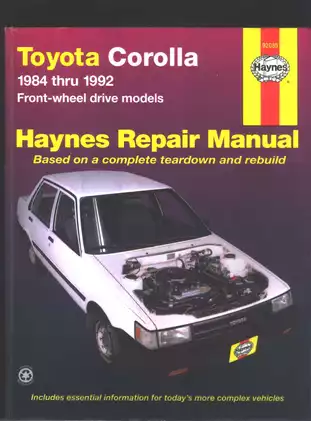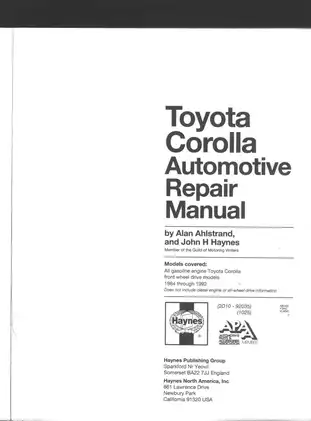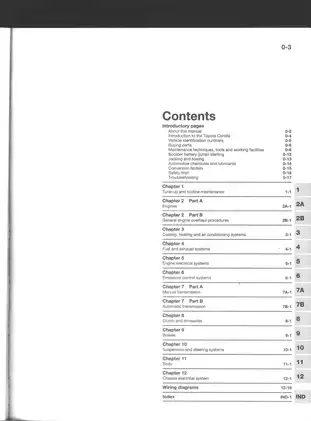Official Toyota Corolla 1984-1992 Repair & Service Manual - Comprehensive Diagnostics & Maintenance
Product Gallery

Sample pages from the Official Toyota Corolla 1984-1992 Repair & Service Manual - Comprehensive Diagnostics & Maintenance manual



Purchase Information
Toyota Corolla 1984-1992 Repair Manual | Haynes Automotive Guide - Technical Specifications
- File Size:
- 52.54 MB
- File Type:
- Language:
- English
- Printable:
- Yes
- Estimated Download Time:
- 1.08 Minutes
- Delivery Format:
- Digital (PDF) - Instant Access
- Category:
- Car
- Brand:
- Toyota
Toyota Models and Parts Covered in this Car Manual
- Toyota Corolla (1984-1992)
Complete Manual Information
Toyota Corolla 1984-1992 Repair Manual
Unlock the full potential of your Toyota Corolla with the comprehensive Haynes Automotive Repair Manual! This manual, expertly crafted by Alan Ahistrand and John H. Haynes, is tailored specifically for 1984 through 1992 front-wheel drive models of the Toyota Corolla, covering all gasoline engine configurations (diesel and all-wheel drive models not included).
Why This Manual is Essential
Maintaining and repairing your vehicle doesn’t have to be a daunting task. This manual is a must-have resource for both novice and experienced DIY mechanics.
Key Features:
- Step-by-step guides for routine maintenance and complex repairs
- Troubleshooting tips to help you diagnose engine issues
- Detailed illustrations to help you visualize the procedures
- Safety and maintenance techniques to prolong the life of your vehicle
What's Inside
The manual is meticulously organized into chapters covering various aspects of your vehicle's system. Here’s a sneak peek into the Table of Contents:
- Introductory Pages
- Introduction to the Toyota Corolla: Learn about your vehicle’s history and specifications.
- Maintenance Techniques: Essential tips and tools for successful upkeep.
- Chapters on Key Systems:
- Tune-up and Routine Maintenance
- Engine Overhaul Procedures
- Cooling, Heating, and Air Conditioning Systems
- Fuel and Exhaust Systems
- Manual and Automatic Transmission Instructions
- Brake Systems
- General Troubleshooting and Diagnostics
- Specialized Tools List for DIY repairs
- Index: Quick reference for specific topics and issues.
This manual not only saves you time and money by providing detailed guidance, but it also empowers you to take charge of your vehicle’s maintenance. Skip the wait at the shop, and tackle issues head-on with confidence!
Order your copy today and ensure your Toyota Corolla runs as smoothly as the day you bought it!
Download Instructions for Toyota Car Manual
Frequently Asked Questions - Toyota Car Manual
What does this Toyota manual cover?
This comprehensive service manual covers detailed repair procedures, maintenance schedules, troubleshooting guides, and technical specifications for Official Toyota Corolla 1984-1992 Repair & Service Manual - Comprehensive Diagnostics & Maintenance. It includes information for the following models: - Toyota Corolla (1984-1992).
Is this manual suitable for beginners?
Yes, this Toyota manual is designed for both professional technicians and DIY enthusiasts. It includes step-by-step procedures with clear illustrations and safety guidelines for Car maintenance and repair.
What file format will I receive?
You will receive this manual as a PDF file (52.54 MB), which is compatible with all devices. The manual is fully searchable and printable for your convenience.
How quickly can I access the manual after purchase?
You'll receive instant access to your Toyota Car manual immediately after payment completion. The download link is valid for 3 days, with lifetime re-download guarantee.
Does this manual include wiring diagrams?
Yes, this automotive service manual typically includes electrical wiring diagrams, component locations, and diagnostic procedures specific to your Toyota vehicle model.
Can I print specific sections of the manual?
Absolutely! This digital manual allows you to print any section you need, from individual pages to complete chapters, making it perfect for workshop use.
Customer Reviews and Feedback
Read what our customers say about this Toyota Car manual and share your own experience.
Add Comment
This policy contains information about your privacy. By posting, you are declaring that you understand this policy:
- Your name, rating, website address, town, country, state and comment will be publicly displayed if entered.
- Aside from the data entered into these form fields, other stored data about your comment will include:
- Your IP address (not displayed)
- The time/date of your submission (displayed)
- Your email address will not be shared. It is collected for only two reasons:
- Administrative purposes, should a need to contact you arise.
- To inform you of new comments, should you subscribe to receive notifications.
- A cookie may be set on your computer. This is used to remember your inputs. It will expire by itself.
This policy is subject to change at any time and without notice.
These terms and conditions contain rules about posting comments. By submitting a comment, you are declaring that you agree with these rules:
- Although the administrator will attempt to moderate comments, it is impossible for every comment to have been moderated at any given time.
- You acknowledge that all comments express the views and opinions of the original author and not those of the administrator.
- You agree not to post any material which is knowingly false, obscene, hateful, threatening, harassing or invasive of a person's privacy.
- The administrator has the right to edit, move or remove any comment for any reason and without notice.
Failure to comply with these rules may result in being banned from submitting further comments.
These terms and conditions are subject to change at any time and without notice.
Comments (1)